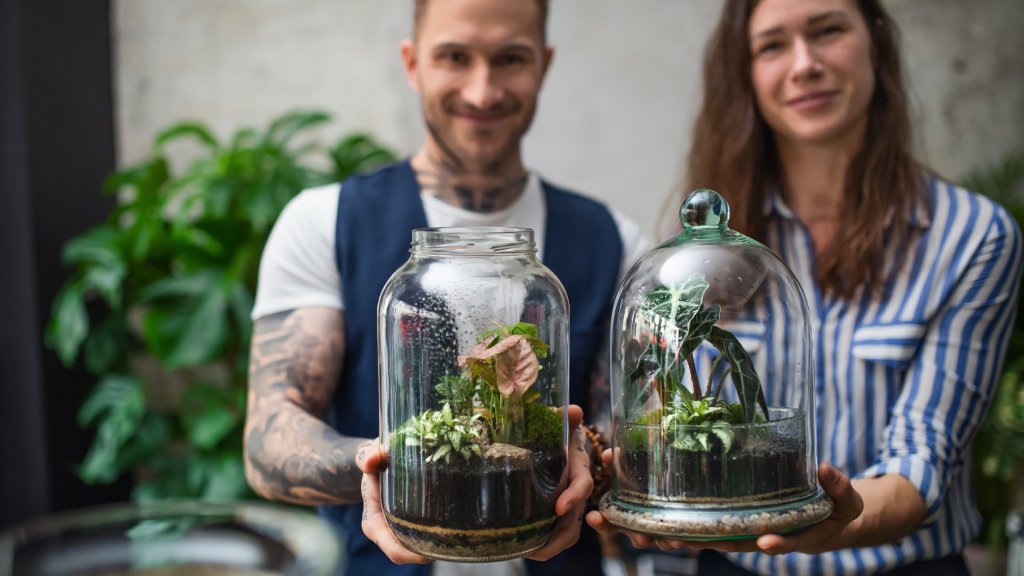Open Vs. Closed Terrariums: Everything You Need To Know
Deciding between open vs closed terrariums depends on your love of the hobby and the plants you want to grow.


Terrariums became popular in the Victorian era after a London doctor accidentally made a garden in a jar. A hobbyist naturalist, he kept a moth chrysalis in a jar of soil so he could observe it. But what he didn’t expect was seeds that were contained in the soil and ready to sprout. The plants thrived for years without adding water or fresh air. He shared his discovery, and the micro gardens became known as Wardian cases after Dr. Nathaniel Ward.
What Is an Open Terrarium?
The original terrarium was a completely sealed glass jar. Today, people experiment with varying degrees of openness in terrarium containers. An open terrarium is not sealed shut and usually has an actual opening that allows for some ventilation.
This is different from a standard container or planting pot. An open terrarium provides some closure with high sides but still has an open spot for ventilation. An example would be a jar without a lid or a glass fishbowl.
What Is a Closed Terrarium?
A closed terrarium has no openings. This allows it to create its own contained water cycle. Purists might consider this the only true type of terrarium and would even insist that the closing is sealed and airtight.
Terrarium Open vs. Closed?
Whether to choose a terrarium that is open a bit or one that’s sealed shut depends primarily on the plants you choose and their care requirements.
Care Requirements
The main care difference if a terrarium is open or closed is watering. A truly closed terrarium should not require any watering. If set up correctly, a closed terrarium will continuously recycle water. It moves from the soil into the plants. Transpiration moves water from the plants back into the air inside the container. The water then condenses into droplets on the inside of the container and goes back into the soil.
An open terrarium requires an input of water. How much and how frequently depends on the types of plants and how open it is. A terrarium with a small opening and plants that thrive in humidity will not need much water. Similarly, a container with a wide opening and plants that do not need much humidity does not require much water.
Gardening tips, videos, info and more delivered right to your inbox!
Sign up for the Gardening Know How newsletter today and receive a free copy of our e-book "How to Grow Delicious Tomatoes".
Plants You Can Grow in Open vs. Closed Terrariums
Another important difference between closed and open terrariums is the types of plants you can grow successfully. Tropical plants that grow in high humidity conditions are best for closed terrariums. Even some types of plants that like humidity will struggle to grow in a closed environment. The high moisture levels can lead to rot.
When choosing plants, consider both the humidity levels and light needs. Low-light plants work best. Plants grown in terrariums generally get light that is indirect and filtered. Direct light from a window can create excessively high temperatures inside the terrarium. Some examples of plants for closed terrariums include:
- Philodendron
- Pothos
- Peace lily
- Venus fly trap
- Ferns
- Moss
- Nerve plant
- Polka dot plant
- Prayer plant
- Peperomia
- Aluminum plant
All of these plants will also grow well in an open terrarium as long as you water them frequently enough. The degree of openness dictates how often to water. Generally, the soil should remain moist.
Non-traditional plants can grow well in terrariums with wide openings and infrequent watering. Cacti and succulents, for instance, will thrive in an open terrarium with plenty of sunlight and drier conditions. Terrariums can be created with different themes, sizes and combinations.
Frequently Asked Questions
Which Is Better: Open or Closed Terrariums?
Neither type is necessarily better. A successful terrarium is a matter of choosing the right plant for the container and providing moisture only as needed. Striking that balance can be difficult and requires some trial and error. In general, an open terrarium is easier to maintain because ventilation helps prevent fungal disease and other types of rot.
Can You Open a Closed Terrarium?
Yes, if you have a closed terrarium showing signs of excessive moisture, mold, or rot, open it to ventilate. Remove any diseased plants and let it dry out a little before closing it again.

Mary Ellen Ellis has been gardening for over 20 years. With degrees in Chemistry and Biology, Mary Ellen's specialties are flowers, native plants, and herbs.
-
 Looking For Plants To Give You The Soft And Fuzzies? Try These 5 Fuzzy Leaf Plant Options
Looking For Plants To Give You The Soft And Fuzzies? Try These 5 Fuzzy Leaf Plant OptionsLovers of texture, drama, silver foliage and tactile plants will adore these special sensory garden additions. These fuzzy leaf plant options will leave you all aglow
By Susan Albert
-
 Get Ready For A Summer Of Hummers! Grow These Full Sun Hummingbird Plants and Flowers
Get Ready For A Summer Of Hummers! Grow These Full Sun Hummingbird Plants and FlowersIf you’re lucky enough to enjoy a sunny backyard, make sure you are maxing out on your pollinator opportunities and grow these full sun hummingbird plants and flowers
By Tonya Barnett